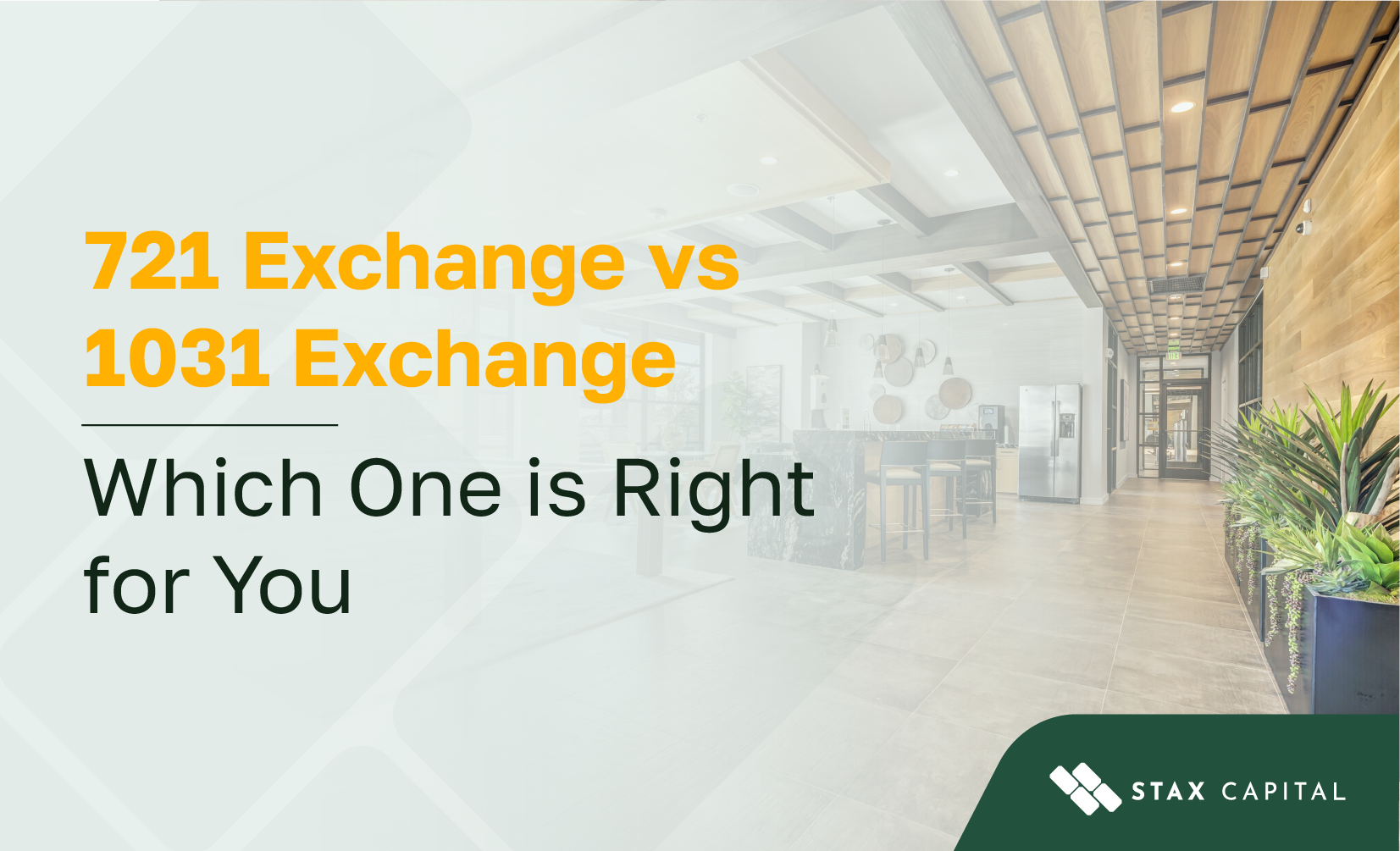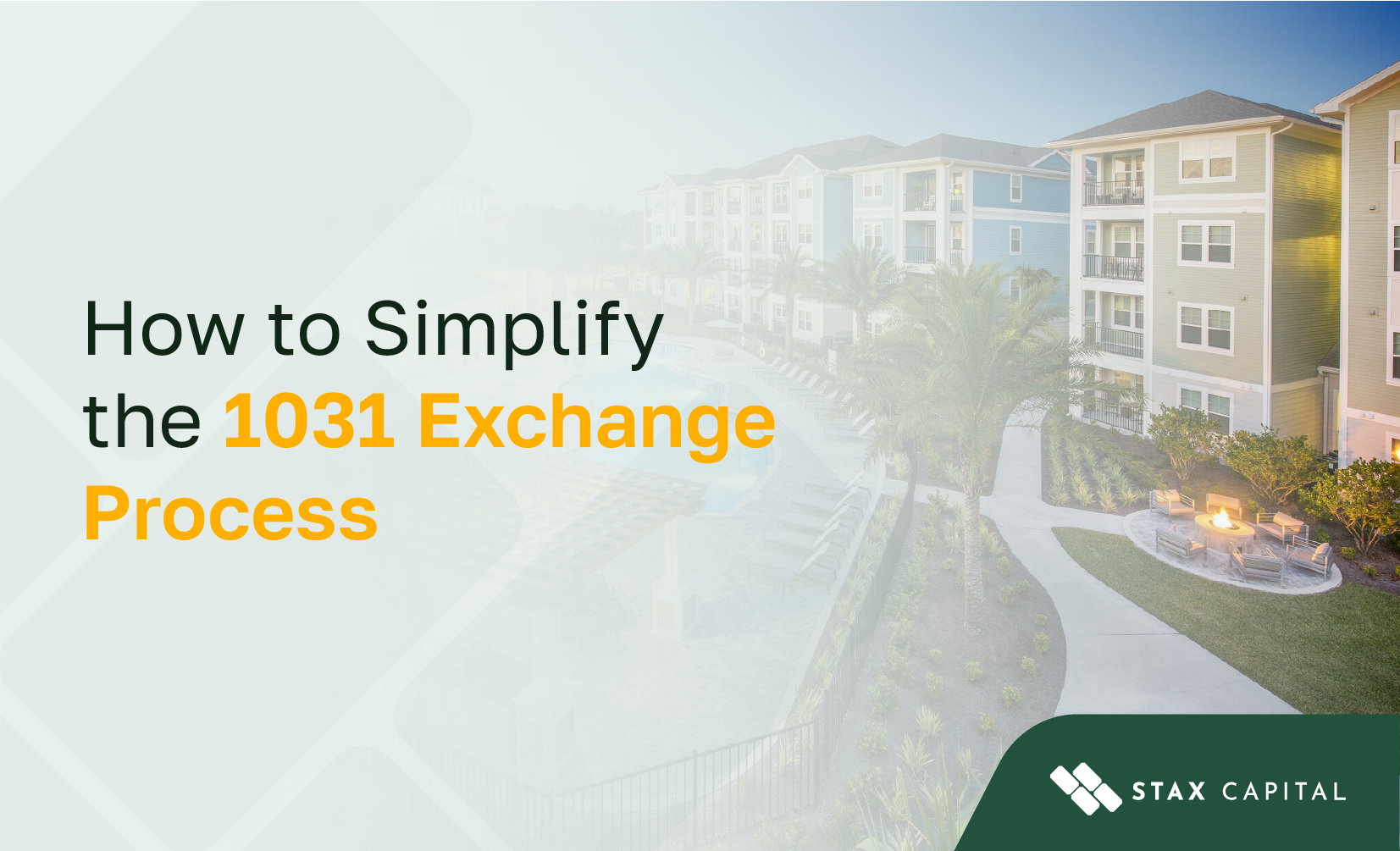DST Exchange vs. 1031 Exchange: Key Differences and How They Work Together

Confused about whether to choose a Traditional or a DST 1031 exchange vs. a DST 1031 Exchange? Both are popular real estate investment strategies that allow real estate investors to defer paying capital gains taxes when reinvesting in like-kind properties, but they serve different purposes.
Understanding their differences is key to optimizing your real estate investment strategy while ensuring compliance with IRS regulations. Let’s explore how each exchange works and how DSTs and 1031 Exchanges offer potential benefits for investment properties.
What Is a Traditional 1031 Exchange?
A traditional 1031 exchange allows real estate investors to defer paying capital gains tax by reinvesting proceeds from the sale of the relinquished property into a similar property or properties. The replacement property must be of equal or greater value, and strict IRS timelines apply. This tax-deferred exchange strategy helps investors grow their real estate portfolios without losing profits to taxes immediately.
While 1031 exchanges offer tax deferral, they require strict adherence to IRS guidelines. 1031 exchange investors should consult qualified tax advisors to ensure compliance with 1031 exchange rules.
What Is a DST Exchange?
A DST (Delaware Statutory Trust) exchange is a passive real estate investment option where investors pool funds into professionally managed properties, gaining fractional ownership. DSTs qualify as replacement properties in a 1031 exchange, offering opportunities for potential income, diversification, and reduced management responsibilities. However, these investments come with risks, including illiquidity and reliance on sponsor management.
Key Differences Between DST Exchange and Traditional 1031 Exchange
Ownership Structure
Ownership in a traditional 1031 exchange means complete control and responsibility. You buy the property directly, handle tenants, and manage upkeep. While this offers control, it requires active involvement.
In a DST exchange, you invest in a trust that manages all aspects of the investment property. You own a portion, while professionals manage operations, providing passive income. While DST ownership provides passive income opportunities, it also means investors have limited control over property decisions, which are handled by the sponsor. This structure suits investors seeking diversification and minimal management duties.
Eligibility
In a traditional 1031 exchange, the investor must reinvest proceeds from a sold business or investment property into another like-kind property within specific IRS timelines. The investor must also take on property management responsibilities after the exchange.
DST exchanges are open to accredited investors only. This means individuals must meet specific net worth or income requirements set by the SEC. The DST structure allows investors to hold fractional ownership in large, institutional-quality real estate properties with the objectives of distributing passive income and long-term capital appreciation.
Liquidity
Traditional 1031 exchanges typically offer higher liquidity compared to DSTs. After completing the exchange, you own the new property and have control over when you want to sell it. This allows you to access your money if needed, but it also means you need to manage the property's sale and deal with potential buyer delays. However, liquidity is still subject to market conditions and the sale process.
In the case of DST exchanges, the investments are typically tied up for a set period, and selling your share before the end of that period can be difficult. DSTs are typically used for long-term passive investors, meaning they’re not ideal for those seeking quick access to funds.
Note: Liquidity in both cases depends on market conditions. While 1031 exchanges offer more flexibility in asset sales, DST investments are long-term and generally illiquid.
Assets sold
In a traditional 1031 exchange, the properties you sell and buy are usually like-kind, meaning both properties must be similar in nature or use. This typically applies to physical real estate, such as residential or commercial properties. You have full control over the specific properties you choose to buy as long as they qualify under IRS rules.
In a DST exchange, the property sold must also qualify for like-kind treatment. However, you are investing in a fractional share of a larger property managed by a sponsor rather than owning an entire property. This allows you to access larger commercial properties, but you lose control of decision-making during the investment period.
Investment returns
In a traditional 1031 exchange, your investment returns depend largely on the property you choose and how well you manage it. You have the potential to generate income or profits based on how well the property performs, including rental income or appreciation. However, you are responsible for the property's management, maintenance, and costs, which can impact your returns.
With a DST exchange, returns are typically more passive. You invest in fractional shares of large real estate assets and are entitled to the income generated from the property's rental or lease payments. Returns are driven by the DST sponsor, meaning you don't manage the property directly but also have less control over how returns are generated.
Note: DST returns depend on rental income or lease payments managed by the sponsor. In both options, returns are not guaranteed and are subject to tenant performance.
How DSTs and 1031 Exchanges Work Together
In a 1031 exchange involving a DST, the process begins when you sell your original property (Relinquished Property) and have the proceeds held by a Qualified Intermediary. Within 45 days, you must identify potential replacement properties, including the DST investment. You then have 135 days to finalize the exchange by purchasing the replacement property using the exchange funds. Failure to complete a 1031 exchange within 180 days can disqualify the tax-deferred exchange benefits.
DSTs offer a passive investment opportunity, allowing you to hold a share in large, professionally managed properties without the responsibility of direct management. Using a 1031 exchange to acquire a DST also allows for more diversification, which is essential when meeting the strict timelines of a 1031 exchange. Additionally, DSTs use non-recourse financing, which limits lender claims to the property itself in case of default. While this offers additional asset protection, it does not eliminate risks associated with the investment.
Note: Using a DST in a 1031 exchange can align with IRS timelines, but investors should work with Qualified Intermediaries to ensure compliance.
Traditional 1031 Exchange Pros
1. Tax Deferral
One of the biggest advantages of a traditional 1031 exchange is tax deferral. Investors can defer paying capital gains taxes on the sale of their property if they reinvest the proceeds into a similar property. This allows for more capital to be reinvested rather than losing a portion to taxes.
2. Full Control Over Property Selection
With a traditional 1031 exchange, investors maintain full control over the properties they choose to invest in. They can handpick properties that align with their goals and investment strategies.
3. Portfolio Diversification
A 1031 exchange allows investors to diversify their real estate portfolios by acquiring multiple properties or property types. This can reduce overall risk and spread investments across different real estate sectors.
4. Estate Planning Advantages
A 1031 exchange can be part of an effective estate planning strategy. Upon passing, heirs can inherit the property with a step-up in basis, potentially reducing the capital gains taxes owed when the property is sold.
Traditional 1031 Exchange Cons
1. Complex Process
A 1031 exchange process can be complicated, requiring strict adherence to IRS rules. Investors must follow detailed timelines and documentation requirements for 1031 exchange, which can be overwhelming without professional help. Missing deadlines or failing to meet specific conditions could result in disqualification from the exchange.
2. Active Management Required
Traditional 1031 exchanges require investors to actively manage their properties. This could include dealing with tenant issues, repairs, maintenance, and leasing. For those seeking a hands-off approach, this could be a major drawback.
3. Tight Deadlines
In a 1031 exchange, time is critical. The investor must identify replacement properties within 45 days and complete the purchase within 180 days. These strict timelines can add pressure and reduce flexibility in choosing the right investment.
4. Limited Property Types
The IRS has clear rules on what qualifies as a like-kind property. This limits the options for replacement properties. Not all real estate investments, such as personal residences or certain types of land, can be part of a 1031 exchange.
5. High Transaction Costs
Transaction costs, such as intermediary fees, legal advice, and closing costs, can add up in a traditional 1031 exchange. These costs will vary depending on the transaction and must be considered in the overall strategy.
6. No Cash Out
Since the goal of a 1031 exchange is to reinvest all proceeds into a new property, investors cannot pocket any of the sale profits. This means they can’t use the funds for other purposes unless they pay taxes on the excess cash.
DST Exchange Pros
1. Passive Income
One of the key benefits of a DST exchange is the opportunity to earn passive income. Since DSTs are professionally managed, investors do not have to deal with the daily tasks of property management. This makes DSTs an attractive option for those seeking hands-off investments. However, income is not guaranteed and may vary depending on property performance and market conditions.
2. Diversification
DSTs allow investors to spread their money across multiple large commercial properties. This diversification helps reduce risk, as the performance of one property is less likely to impact the overall investment. With a DST, you can gain exposure to different asset classes, sectors, and locations, further strengthening your portfolio.
Note: Diversification may help reduce exposure to market fluctuations, but it does not eliminate investment risks. Investors should consider individual goals and consult advisors.
3. Access to High-Quality Properties
DSTs typically invest in large, institutional-grade properties like office buildings, shopping centers, and apartment complexes. These properties often have better returns compared to smaller, individual investments. As an investor in a DST, you get the opportunity to invest in such properties without needing large amounts of capital.
4. Pre-Packaged for 1031 Exchanges
DSTs are structured to comply with 1031 exchange rules, making them an ideal solution for investors looking to defer taxes. They are designed to be quickly purchased within the tight timelines of a 1031 exchange, helping streamline the process.
5. Non-Recourse Financing
Many DSTs use non-recourse financing, which means that if the property fails, the lender can only claim the property itself, not the personal assets of the investor. This provides an added layer of protection for investors.
DST Exchange Cons
1. Limited Control
One downside to DSTs is that investors have limited control over the property management and day-to-day decisions. Since the properties are professionally managed, investors must rely on the management team to make all operational decisions, leaving them with less influence over their investments.
2. Illiquidity
DSTs are generally illiquid investments. Unlike stocks or bonds, DST shares cannot be easily sold or accessed, meaning investors must hold onto their investment for the long term. If an investor needs to access their funds quickly, they may face challenges.
3. Limited Exit Strategy
If investors want to sell their DST interest before the property is sold, they may face difficulties finding a buyer. This limits the flexibility and exit options for investors, making it less ideal for those who may need liquidity in the near future.
4. Fees
DSTs can come with a variety of fees, such as management fees, acquisition fees, and property operation fees. These can reduce the overall return on investment, especially when compared to more direct forms of real estate ownership.
Factors to Consider When Choosing Between DST Exchange and Traditional 1031 Exchange
Investor goals (passive vs. active management)
If you're someone who wants to take a step back and avoid the day-to-day responsibilities of property management, a DST exchange might be the better choice. It's a passive investment, meaning you don't have to handle the upkeep of the property. On the other hand, if you enjoy being involved in property management and have the time to oversee the details, a traditional 1031 exchange gives you full control over the properties you choose.
Portfolio diversification needs
Diversification is key to managing risk. DSTs allow you to spread your investments across multiple properties, which can offer better protection against market fluctuations. If you're looking to minimize risk by holding a variety of assets, DSTs can help you achieve that. In contrast, a traditional 1031 exchange often means you're focusing on fewer properties, which might expose you to more risk if one property doesn't perform as expected.
Tax deferral strategies and estate planning
Both DST exchanges and traditional 1031 exchanges allow for tax deferral, but your long-term plans can influence the choice. If you're interested in deferring taxes and potentially passing assets on to heirs without triggering immediate taxes, both options offer similar benefits.
However, DSTs may have advantages for those looking for estate planning solutions, as they allow for a more hands-off approach while still benefiting from tax deferral strategies. A traditional 1031 exchange, on the other hand, requires more active involvement, which may be better suited for some investors' goals.
Take Control of Your Investment Future
DSTs and 1031 exchanges offer unique opportunities for real estate investors. Choosing the right strategy depends on your goals, risk tolerance, and level of involvement.
To learn more and explore options that align with your financial strategy, contact our team for guidance.



Share: